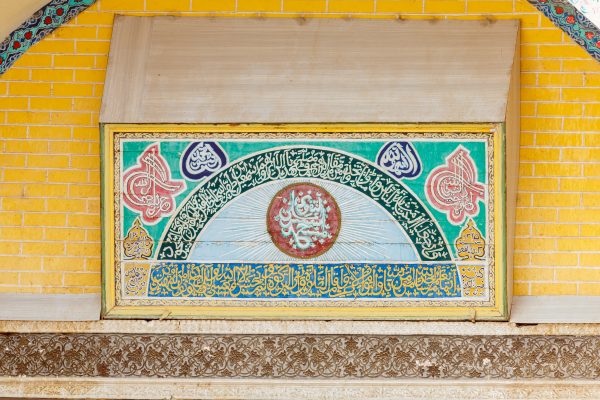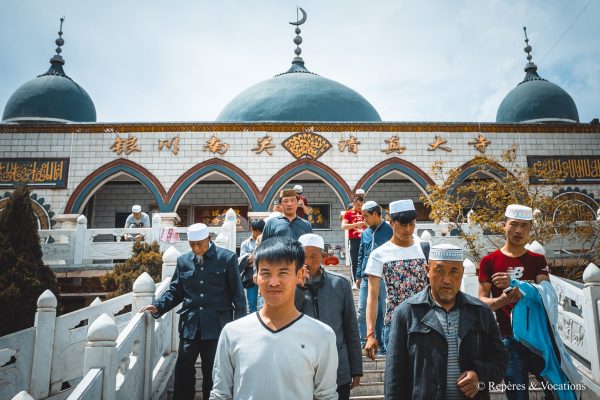China has now partially destroyed and removed the historical Islamic scriptural plaque at the entrance of the Id Kah mosque in the city of Kashgar, as well as the star-and-crescent symbols at the top of the mosque. Id Kah is the largest and oldest mosque in Xinjiang, with Uyghurs regarding this mosque as an important symbol of faith and historical importance.
China has now partially destroyed and removed the historical Islamic scriptural plaque at the entrance of the Id Kah mosque in the city of Kashgar, as well as the star-and-crescent symbols at the top of the mosque. Id Kah is the largest and oldest mosque in Xinjiang, with Uyghurs regarding this mosque as an important symbol of faith and historical importance.
China’s horrendous human rights abuses and violations of international law against Uyghur and other ethnic minority Muslims have been rightfully labeled a genocide by human rights groups across the world – the mass concentration camps, where up to 2 million are held in detention, the systematic and state-sponsored destruction of Uyghur culture and heritage, and the continued torture, abuse, and extra-judicial killings are continuing even under the watchful eye of the international community.
China’s impunity, paired with its economic and political power that has caused many nations to turn a blind eye to these horrific human rights abuses – including Muslim-majority nations who continue to bask in China’s friendship – has allowed Uyghurs and ethnic minority Muslims to suffer under a relentless genocide for years.
Since 2016, China has also, as part of its program of cultural genocide, been destroying mosques, historical Uyghur cemeteries, and other religious centers in an attempt to eradicate the culture and history of the Uyghur peoples of the Xinjiang region.
According to a report by the US-based Uyghur Human Rights Project (UHPR), China has destroyed between 10,000 to 15,000 mosques and other religious sites in Xinjiang from 2016 to 2019. In some cases, entire mosques were destroyed, and in other cases, Islamic symbols and the domes of mosques were destroyed in an attempt to de-Islamify these religious and historical centers.
In the most recent reports, China has now partially destroyed and removed the historical Islamic scriptural plaque at the entrance of the Id Kah mosque in the city of Kashgar, as well as the star-and-crescent symbols at the top of the mosque. Id Kah is the largest and oldest mosque in Xinjiang, with Uyghurs regarding this mosque as an important symbol of faith and historical importance.
The plaque’s whereabouts are reportedly unknown – dating back to around 1908, the plaque (pictured below) contained scriptures from the Holy Quran as well as information about the identity of the artist.

Speaking to Radio Free Asia, Turghunjan Alawudun, the Director of the Religious Affairs Committee for the World Uyghur Congress (WUC), explained that Chinese authorities often leave mosques intact structurally to leave an impression on visitors or the international community that there is religious freedom – but by removing Islamic symbols and implementing restrictions on participating in mosque activities, this essentially bars Uyghurs from any sort of freedom. Alawudun continued:
The disappearance of the scriptural plaque from the entrance to Id Kah is one aspect of the Chinese regime’s evil policies meant to eliminate the Islamic faith among Uyghurs, to eliminate Uyghur faith, literary works, and language—and Uyghurs themselves.”
Henry Szadziewski, a senior researcher with UHRP, also spoke of the dangerous implications the partial destruction of the Id Kah mosque has for the Uyghur community at large, who continue to be targetted and even killed for expressing any affiliation towards Islam:
The removal of Islamic motifs from the building tells a different story. It tells us Id Kah is being stripped of religious meaning to become a shell for unsuspecting visitors. There is no reason to remove Islamic motifs from the building other than to demonstrate to Uyghurs that belief in Islam belongs to the past. As such, the despoiling of Id Kah signals a move toward an effective ban on the Islamic faith.”
China continues to deny any wrongdoing in its continued genocide against Uyghur and other ethnic minority Muslims in the region – as of today, millions continue to be detained in horrifying concentration camps across the northwestern province of Xinjiang. It remains to be seen for how long the international community will remain silent in the face of one of the world’s worst human rights abuses in the modern age.





